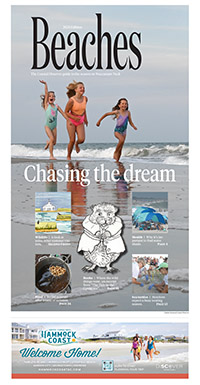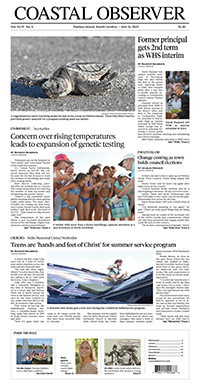Environment
DNA tests on sea turtles gather data on ‘cool dudes’

Volunteers are on the lookout for “hot chicks” and “cool dudes” buried in the sand this summer.
S.C. United Turtle Enthusiasts, better known as SCUTE, has collected maternal DNA from sea turtle nests for the last 15 years to track the mothers of hatchlings and study their nesting habits.
Now they’re collecting paternal DNA for analysis due to concern that rising temperatures are reducing the number of male sea turtles and threatening the species’ future.
“There’s a big scuttlebutt about global warming and the nests getting really, really warm. The nests, theoretically, are coming out with more, much more, female turtles than male turtles,” said Rick Scott, the head of SCUTE. “That’s kind of a big concern right now.”
The temperature of the sand where a nest incubates determines the sex of the hatchlings. Higher temperatures produce more females, hence the “hot chicks.”
Mary Schneider, the SCUTE coordinator on Pawleys Island, said the process to extract the maternal DNA is simple. If an egg is broken during the relocation of a nest, that’s used for a DNA sample.
“We can use that so we don’t have to sacrifice an egg that’s still viable,” she said.
However, Schneider said it’s not that easy to collect the paternal DNA, which requires clipping half an inch off of a dead hatchling’s flipper. It isn’t unusual to find dead turtles when volunteers conduct nest inventories.
While onlookers are eager for a glimpse of live hatchlings that volunteers release at the edge of the water, those who don’t survive the nest provide information for research.
“Personally, I hope we don’t have another sample this whole summer for male DNA because that would mean that we had a dead hatchling in the nest. It’s not something I’m looking forward to doing,” Schneider said. “But it’s viable information for turtle research.”
Scott said he typically comes across a dead sea turtle half of the time he’s out counting turtle eggs for inventory.
“Even though it died, there was some good that came out of it,” he said. “Now the research is being expanded to try to figure out, do we have one male out there that’s impregnating all these females? Or do we have many males?”
SCUTE partners with the state Department of Natural Resources and Dr. Brian Shamblin, a senior research scientist at the University of Georgia who tests the DNA.
The yolk and albumen, or egg white, contains DNA of both parents. The maternal DNA is extracted from the nucleus of the ovum found inside of the shell.
Those who have a letter of authorization from DNR to handle the turtles, including Schneider and Scott, collect the samples by rolling the eggs and fins up and placing them inside a vial of alcohol. A DNR representative then collects them and logs them into a database before the samples are shipped to Shamblin for analysis. He assigns each turtle a unique identification number and enters them into databases such as seaturtle.org.
“The turtles, in the early years, have now grown up and we see them coming back to the beach,” Scott said. “We know that this genetic imprinting is solid science in that regard.”
In order for the turtles to be removed from the threatened species list, the state must continually see 6,000 turtles per year. The state is just under 4,000 this year. Each nest laid typically holds 120 turtle eggs.
Schneider, a volunteer with SCUTE for 30 years, said the first nest to hatch on Pawleys Island had more than a 90 percent success rate. There were 19 nests on the island this summer as of last week.
There were 17 nests on the Litchfield Beaches, including Huntington Beach State Park. DeBordieu had 25.
“When I first started doing this, we would have eight or 10 nests on Pawleys,” Schneider said. “So we know that we’ve made a difference in protecting nests.”




